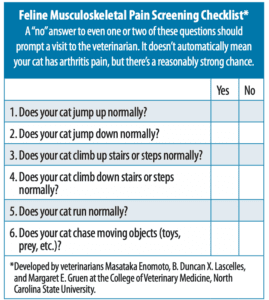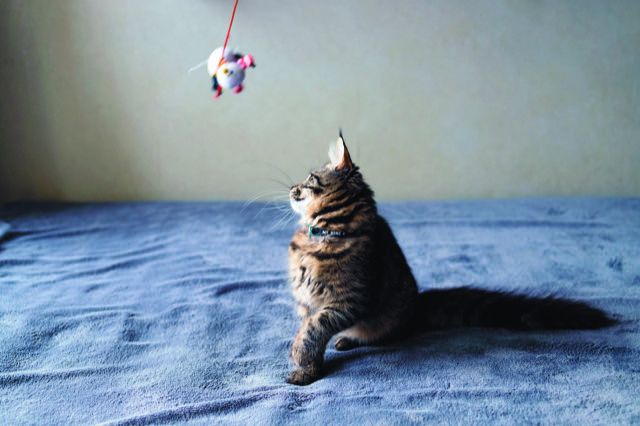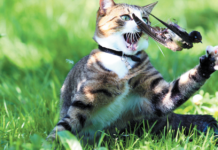Some 90 percent of cats develop arthritis over time, research suggests, with about half of them actually suffering from arthritis pain. That comes to almost one out of two house cats in pain, yet people often aren’t aware. They think their cat isn’t as nimble simply because he’s getting older. Or they believe that if a cat had arthritis, he would start limping. But while dogs limp from arthritis pain, cats work to hide their discomfort. They like to mask their vulnerability so predators can’t see their weakness. No matter that there may be no predators in your home. That feline tendency is genetically built in.
The upshot to the lack of recognition of arthritis pain: fewer than 1 percent of cats suffering from the disease are taken to veterinarians to see what can be done to ease their discomfort. That’s a lot of bone-on-bone rubbing when joint cartilage wears away as a result of arthritis. It means two bones keep scraping against each other as a cat moves about. That’s what causes the discomfort.
 To help cat “parents” better detect arthritis pain, researchers have come up with a simple 6-question survey that can be answered with “yes” or “no” responses in less than a minute. If you find yourself answering with even one or two “no’s,” it’s worth taking in your cat for a checkup. It’s not a guarantee that your pet has arthritis, but it means there’s a reasonably high possibility. Your vet can then take x-rays and, if arthritis is diagnosed, ratchet down your cat’s pain with analgesics. A modified exercise regimen and a weight management plan may help, as well. Excess weight causes undue pressure on the joints.
To help cat “parents” better detect arthritis pain, researchers have come up with a simple 6-question survey that can be answered with “yes” or “no” responses in less than a minute. If you find yourself answering with even one or two “no’s,” it’s worth taking in your cat for a checkup. It’s not a guarantee that your pet has arthritis, but it means there’s a reasonably high possibility. Your vet can then take x-rays and, if arthritis is diagnosed, ratchet down your cat’s pain with analgesics. A modified exercise regimen and a weight management plan may help, as well. Excess weight causes undue pressure on the joints.




